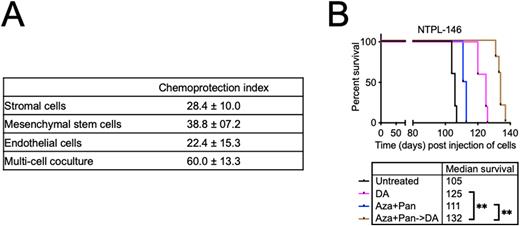Abstract
KMT2A is the most common gene rearrangement in pediatric acute leukemias and is difficult to treat with a five-year overall survival rate of less than 50%, owing to frequent relapse and poor response to chemotherapy. Recent studies have investigated how interactions within the bone marrow microenvironment help AML cells evade chemotherapy and contribute to relapse by promoting the survival of leukemic blasts. Our group has previously identified that epigenetic drug combination of DNA hypomethylating agent azacitidine and histone deacetylase inhibitor panobinostat reduces cell adhesion and promotes mobilization of leukemic cells to peripheral blood (Weber et al., 132:2637, Blood, 2018).
In this study, we used a multi cell coculture of pediatric AML cells with bone marrow stromal cells, endothelial cells and pediatric mesenchymal stem cells to better mimic the bone marrow microenvironment. We observed that the chemoprotection index in multi-cell coculture was much higher than individual cell type (Figure 1A). While 1.5 uM cytarabine reduced MV4;11 cell viability by 50%, there was less than 1% reduction in cell viability in multi-cell coculture. We further investigated if the bone marrow microenvironment induced chemoprotection was mediated by soluble factors, or via adhesive interactions between adherent cell layer and/or the extracellular matrix (ECM). Conditioned media failed to afford chemoprotection, while separation of AML cells from multi-cell layer via Transwells or culturing AML cells in Matrigel-coated dishes showed partial chemoprotection. These results indicated that direct cell-cell or cell-ECM contact was necessary for the chemoprotection.
Pre-treatment with azacitidine and panobinostat sensitized five distinct patient-derived xenograft (PDX) lines of KMT2A-rearranged AML to both cytarabine and daunorubicin in multi-cell coculture. These data indicate that azacitidine and panobinostat combination can synergistically overcome chemoprotection mediated by stromal, endothelial and mesenchymal stem cells. We also observed improved survival with pre-treatment of azacitidine panobinostat (2.5 mg/Kg each, Qd5) followed by chemotherapy consisting of cytarabine (50 mg/Kg, Qd5) and daunorubcin (1.5 mg/Kg, Qd3) in a PDX model of KMT2A-rearranged AML (Figure 1B, **P<0.05).
To determine if these epigenetic modifers alter the expression of cell adhesion molecules, cells treated with azacitidine panobinostat combination were subjected to a high throughput flow cytometry assay (Lyoplate, Human cell surface marker screening panel). This analysis showed reduced cell surface expression of integrins, ICAMs and chemokine receptors, indicating that epigenetic drug combination likely causes mobilization and chemosensitization via downregulation of cell adhesion molecules which not only mediate adhesive interactions but also promote cell survival. In summary, our data show azacitidine and panobinostat can overcome bone marrow microenvironment induced chemoprotection in vitro and in vivo in KMT2A rearranged AML.
Disclosures
No relevant conflicts of interest to declare.
Author notes
Asterisk with author names denotes non-ASH members.


This feature is available to Subscribers Only
Sign In or Create an Account Close Modal